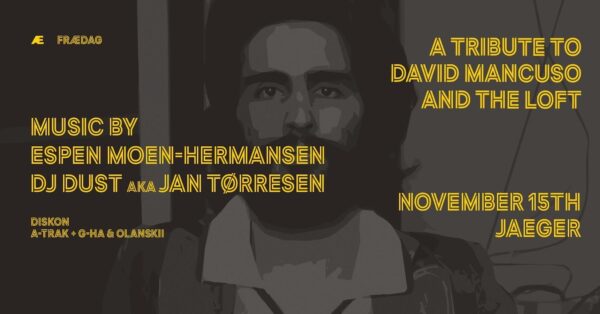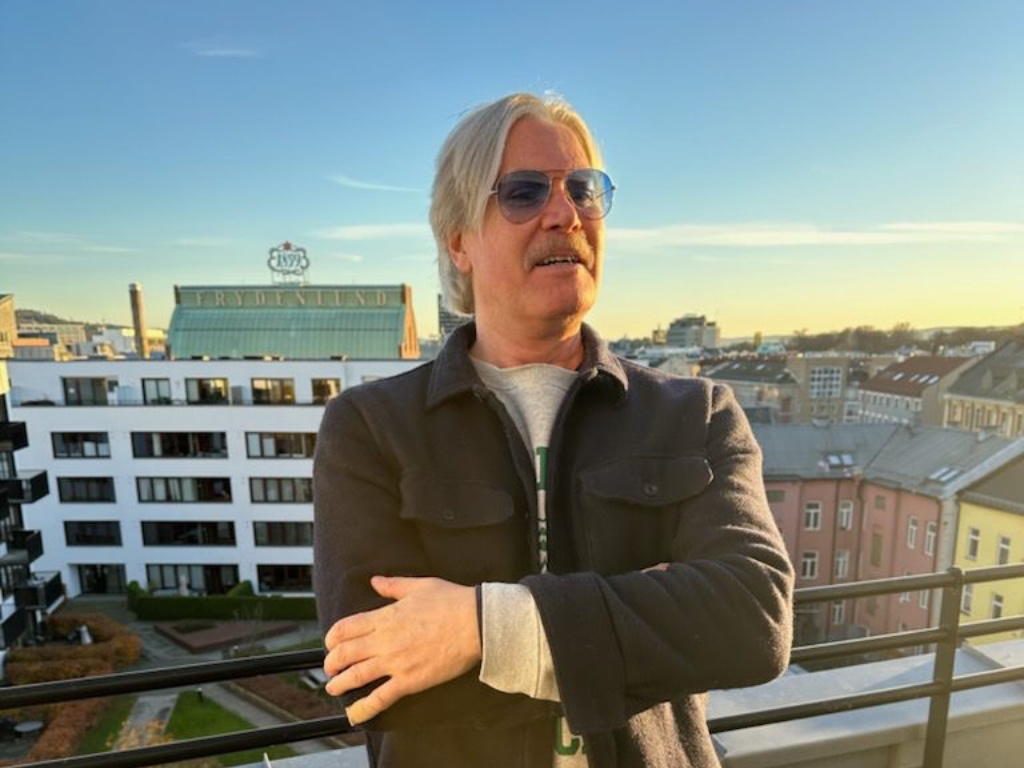DJ Dust has been a touchstone in the Oslo scene as a Funk savant, an NRK broadcaster and a Headon O.G. We talk to him about all those things and more ahead of his set with Espen Haa for our next Loft and David Mancuso tribute.
“The only problem I have is that all my records are in a big container, and I’m in the process of finding… ”
“The container?”
“No, the music I’m going to play.” (laughs)
I Imagine Jan Tørresen (aka DJ Dust) waist deep in a sea of black shellac, wading through tattered sleeves featuring all kinds of people dressed in seventies attire, a collage of comic book characters brought to life. “I have no order, that’s the problem,” he muses over a telephone call from his home in Grimstad.
Jan is preparing for a visit to Jaeger’s sauna alongside Espen Haa for the annual Loft and David Mancuso tribute, which comes with a set of very strict rules from Espen. “And I have to abide by those rules, so I’m gonna play the Loft classics.” Fortunately he has collected a fair few of those ”Loft classics” over the years and, hidden somewhere in his disorderly record collection, they’re just waiting to be rediscovered.
Jan Tørresen has been collecting and playing records since his early teens. Back then Grimstad was a “sleepy southern town” where “nothing happened” according to Jan, but there were two record shops. Jan had an early fascination for music and by the age of 14 he was DJing at school parties. There was only “one other DJ in Grimstad” according to his memory, but Jan had an early distinction from his peer for being… the worst at it.
“I just played new music and they hated it,” he recalls with guffaw. ”I didn’t know anything about DJing. All I knew was that I liked to play records, but I didn’t know what people wanted so I didn’t give people what they wanted.” With the exception of a few close friends, it didn’t make him very popular, but he was still determined.
He recounts one specific incident at his first gig outside his hometown: “I remember I played Grandmaster Flash and the Furious Five’s ‘Wheels of Steel’ in Kristiansand, and I was asked to leave. “ It wasn’t an isolated incident apparently, but he was only a teenager at the time. “I thought people wanted to hear some really funky shit, but all the people wanted to hear was Creedence Clearwater Revival and Bob Dylan.”
While Jan’s love for music wasn’t much reciprocated in his community there was a lot of interest in music and Djing in Norway, proliferated by a musical émigré class. “Back in the eighties there weren’t many Norwegian DJs but there was a big demand for DJs all over Norway and the UK supplied those DJs.” Those DJs in turn needed access to the latest records from abroad and record stores started to pop up all over the country to supply these DJs, record stores owned and ran by many of these same DJs. By the time Jan turns 16, a third record store opens in Grimstad. It was called Mike Lewis’ records, named after just such an English DJ.
Jan started working there in 1982. “That was heaven to me, because that was direct-import disco stuff.“ He took his salary in records, but even that didn’t endear him to the dance floors around Grimstad. “I played the music that they were playing in the hippest nightclubs in New York in Grimstad, and of course they didn’t understand it. I loved that music, and I was under the impression that the music that I was playing in my room, the music I went bananas for, they were gonna love it, but they hated it of course.”
A lot of what he was listening to in his bedroom was Funk, and the music genre hadn’t reached those uber-cool levels it had enjoyed in the USA at that point. Jan was way ahead of his time. After hearing Funkadelic’s Aquaboogie, Jan was hooked and he assumed others would be too. ”I just fell into it,” recalls Jan, before continuing, “it just felt right for me.” People might have hated it, but he was probably the only one playing it around that time, and soon enough everybody comes around.
He learned to adapt and started playing more of the music he thought people wanted to hear. It coincided with the opening of Skyline in Grimstad by 1985, a place where Jan would truly start cutting his teeth as a DJ. It was a “very modern looking place for Grimstad” and the “best disco in the south of Norway”. During his time at Skyline Jan really “started to understand the politics of dancing.” It didn’t stop him however from sneaking in a Funk oddity in his sets, something that could “clear the dance floor, just for the hell of it.”
By the time he moved to Oslo in 1990, a shift in attitudes towards this music started to appear. His earliest tastes in music ossified around Funk, Soul and Disco, and he was determined to make this work and it seemed the capital was following a similar path.
Armed with a box of Funk, Jan was set loose on Oslo. ”I checked out what the coolest club was and asked if I could play, and you know what they said?” Jan asks rhetorically. They said “see you on Friday.” It was a time when you could still make a living as a DJ. DJs were still set apart at that stage, because not only did they have to intrinsically understand those “dance floor politics” as Jan put it so eloquently earlier, but they also had to have the records. Jan’s salary in records that he had been stockpiling, put him in a league of his own.
“My collection was quite unique,” he boasts “because of my job at Mike Lewis’ record shop, I had all the records nobody else had.” Those American and British imports had set Jan apart early on, and his selections soon caught the ear of the people behind Headon; a club that would change the landscape of Oslo’s club culture for generations to come. They had “heard I played Funk and Soul and Disco stuff,” remembers Jan. “They came down there and asked me to play at Headon. Everything was much easier, because there were fewer DJs back then.”
Jan’s “vast 7” collection with really hardcore funk” was the perfect match for Headon’s immoveable Funk philosophy at that time. Unlike Grimstad, he could play “hardcore Funk and it worked because people hadn’t heard that in a club in Oslo before.”
By the mid nineties Jan’s reputation as DJ Dust preceded him. Wherever “people needed funk, I delivered” and it turned out that even the radio needed the Funk. National broadcaster NRK and P3 had heard the shockwaves of club music passing through the country. They had already enlisted the help of Olle Abstract and Pål Strangefruit in courting a younger audience dancing to many raves and nightclubs that were thriving in Oslo at that time. NRK thought they needed a third addition to their roster to complete the sonic triptych of Oslo’s nightlife and approached Jan on the merits of his appeal at Headon, but they wanted a little more than music at first.
“They asked me to do some comedy, because believe it or not I can be quite funny sometimes.” The idea was to interlace the music selections with comedic “skits” but time and resources proved wanting. Jan was working at Virgin Music as a product manager by that time, and between Djing and his day job, the music would have to suffice for broadcasting purposes.
It was a golden epoch for Norwegian public radio with Olle, Pål and Jan on the airwaves, conveying something of a subculture through national airwaves, and it’s something that has been lost since. Besides perhaps Frantzvaag’s weekly radio show, NRK’s programming today appears conservative in tastes and range and completely out of touch with what’s happening on the dance floors of Oslo. When pressed about that period in broadcasting and their liberal pursuits, Jan can only offer: “I wish I could give you an answer to that, but I don’t know.”
What he does know however is that his work at Headon was the foundation for his work in broadcasting and for a period between 1997-2002, he was a very influential selector in the scene. He continued to play at Headon, and was one of the only DJ’s to play there for the entire lifespan of the institution. As the club and its DJs matured, they would relax their music policy, opening the hardcore Funk establishment up to Soul and Disco, but stopping short of any contemporary electronic sounds, which was the main purview of places like Skansen and Jazzid at that time.
Jan would also move on from his beloved Funk into the realm of Disco for his radio show on NRK toward the end of his incumbency. It coincided with a vital time for what would be a burgeoning Space Disco scene coming out of Oslo. Jan doesn’t believe it had any direct influence on the scene, but he does acknowledge that “Lindstrøm listened to it (his show)” and he distinctly recalls giving “Prins Thomas a gig at Headon when he was just a kid.”

Even twenty years on, nights like this Loft Tribute and the sounds we hear on the dance floor week in and week out, has interned Disco’s endless appeal in Oslo. “It’s groovy, it’s uplifting and it’s fun,” reflects Jan about Disco’s everlasting charm. Yet again I get the “I wish I knew” on why something is the way it is, but for Disco’s enduring love, he can guess that it is because “there’s Disco in new music.” He singles out Sabrina Carpenter’s espresso as an example, and for his own love for the genre he is unbiased.
“I love both the organic Disco and the electronic Disco,” he insists. His hardline Funk pursuits softened over the years and “in the last ten years” he’s even “been doing some new stuff.” Back in the nineties, he wouldn’t play anything beyond the ninety eighties, but today you could find DJ Dust playing a newly released House cut.
When he did the Jaeger Mix in 2019, he kept it strictly eighties synth Disco with tracks from Scritti Politti and Mtume alongside some of that signature Funk sound. That was the last time we had a DJ Dust set at Jaeger. We don’t often get the opportunity to hear a DJ Dust set here in Oslo, so when he does we’re guaranteed something special. During our interview for that Jaeger Mix, he joked about hanging up his headphones “lots of times” in the past, but never could quite make it stick. “It’s when you get out there and start playing and you see people really enjoy the music and dance their ass off, it makes it all worthwhile.”
Today he still works within the music industry as a freelance music supervisor, marrying music with films and adverts. That side of his musical personality remains “completely different” to what he does in the capacity of a DJ. Like any other job, it’s just there to facilitate the passion, and Jan’s passion remains strong for his first love. Back in 2019 he said, “my heart still beats faster when it comes to soul, funk and disco” and that remains the case today.
I leave Jan to his digging as I hang up, picturing again the Norwegian DJ in a container somewhere in the south of Norway. We don’t know what he’s going to play, but whatever it is we can be sure that DJ Dust will bring the Funk!

